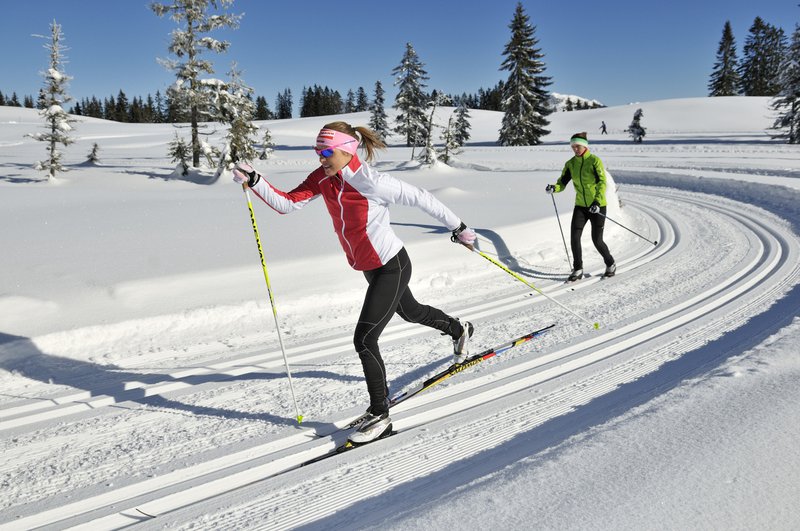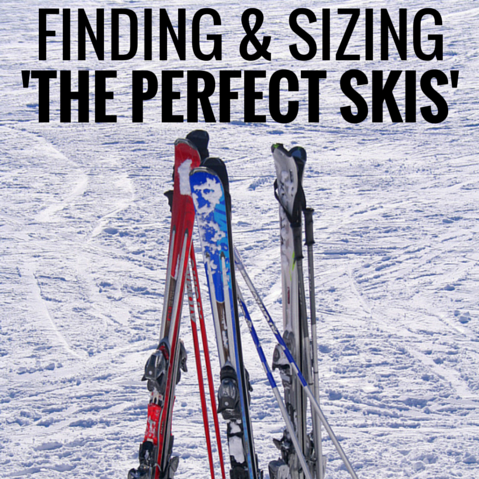Men’s Skis Sizing Chart
Women’s Atomic Skis Sizing Chart
Step 2- Select Your Ability
Step 3 – Select Your Terrain Preference
Step 4 – Type of Ski
About sizing skis- Getting the proper ski length is important. Get too long of ski and it’s hard to handle. Get a ski too short and you have stability, edge hold and response problems. You can not select a ski length first and then select a ski model. Instead, you must first select the ski model and then select the proper ski length.
A few additional things you should know-
- Intermediate skis are made longer than beginner skis. Performance skis are made longer than intermediate skis.
- If your weight puts you between ski lengths, go up in length if you’re taller than average. If you’re shorter than average, go down one length.
- There is no standardization between manufactures when it comes to ski length. Ski manufactures make any length they think is right for their model. You could be in a 151 cm in one model, a 157 cm in another model, and a 163 cm yet in another model.
- DO NOT choose a length first. Choose the model first, then the length.
Sizing Cross Country Skis

Fischer Nordic Ski Recommended Lengths
Sprint Crown Junior Skis
Flex
Some skis are designed to be easier to bend, both along their length and torsionally (twisting from side to side). Soft flexing models are easier to turn while stiffer ones offer more stability, especially at speed, and for heavier skiers.
Sidecut
This refers to how curvy or straight the sides of skis are. Old school skis were almost straight up and down; all types of modern skis tend to have narrower waists than tips, giving them curvier, hourglass shapes. In general, this makes them easier to turn, especially on piste, however a very deep sidecut means less stability at speed. On-piste skis have the narrowest waists for better grip, while skis with wider waists (and less difference between waist and tips) have extra float, making it easier to tackle variable, off-piste terrain.
In our ski reviews, sidecut is defined by ski width at tip, waist and tail, expressed in millimetres (eg 122/80/110), alongside the length of the skis it refers to in centimetres (eg 170).
Radius
This governs the size of turn skis would naturally make when tipped on edge without pressure. The radius of curvy-sidecut slalom skis might be 12m, and can be as big as 44m for straighter sided, fatter big-mountain skis. Some skis are multi-radius, meaning the natural turn size changes along their length (often big at the front for ease of starting turns, tight at the rear for ease of finishing them).
That’s why skis in our reviews may have two or more radius figures.
Rocker
Traditionally, skis are raised off the ground in the middle (see ‘Traditional camber’ below). In its simplest terms, rocker means that if laid flat the centre of a ski touches the slope while the tip and tail curve up more than usual. This makes turning in powder easier, so most all-mountain, freeride and big mountain skis have some form of rocker. The downside of rocker is that it can detract from grip and stability on piste, so to make on-/off-piste performance more balanced, skis may have partial rocker – just at tip and tail for example, with a more traditional construction in the middle for improved grip. Even park & pipe skis may have some rocker, to help with pivoting and buttering.
• Freeride ski test winners
Traditional camber
The opposite of rocker. Tips and tails make contact with the ground when skis are laid on a flat surface, and there’s a gap under their centre. This shape can make it easier to transfer weight to the tips and tails, helping with grip. A bigger gap under the centre also makes skis livelier. Most on-piste skis have traditional camber (sometimes with ‘Tip rocker’ – see below). Park & pipe skis tend to have traditional camber to maximise pop.
Tip rocker
Some on-piste skis have a little rocker, usually at the tips only. Although rocker is generally used to help with float off piste, tip rocker can also help with starting turns on groomed snow.
Reverse sidecut
Some powder skis with rocker get wider instead of narrower from the tips back towards the middle of the shovel, before narrowing again towards the waist, to help with float. The same may apply at the tail. Termed reverse sidecut, it’s intended to increase float in powder.
This can mean there are four or five width measurements for sidecut in our ski reviews, instead of three.
Mounting point
Skis have a recommended mounting point for bindings – most are mounted slightly back of centre. Generally, the further forward bindings are, the easier skis are to pivot (on snow and in the air) and the more playful they feel. The disadvantage is that the tips tend to submarine in deep snow, and the skis tend to be less stable in long, fast turns. When buying bindings separately from skis, sometimes there’s a choice of mounting points, so you can specify the one that suits your skiing style. Even with integrated bindings, there’s sometimes an option to move the binding toepiece forwards or backwards to adjust stance on the ski.
Best Men’s All-Mountain Skis of the Year
What does “all-mountain ski” mean?
- From groomed runs to moguls to the steep-and-deep freeride terrain, all-mountain skis are designed to take on the entire mountain. They usually feature a waist between 85-100 millimeters and are sold without bindings. The majority of all-mountain skis that our testers prefer feature wood cores and two sheets of metal—but there are exceptions about the metal, including the Head Kore and Scott Slight families. Although versatile, many all-mountain skis are a bit too narrow for very deep powder skiing.
How long do skis last?
- With proper care and regularly performed tuning by a professional ski tech, skis can last for 200-300 days on snow depending on the size and aggressiveness of the skier. Larger skiers and people who are harder on their equipment will not get as many days on snow before the wood core, edges, or other aspects of the ski become compromised. Bindings should be tested by a professional ski tech every season, and replaced when they do not meet standardized norms.
For skiers who want to rule the mountain, these skis are where to start. They can take on groomed, chop, bumps, power, the list goes on. You call it, they ski it. And like well-trained dogs, take the leash off and let these ski do the work all over the mountain.
The Best Men’s All-Mountain Skis of 2020
BEST IN TEST: Head Kore 93

The 2020 Head Kore 93 had the highest score of any ski at SKI Test in Taos, N.M. Photo courtesy of Head
The narrowest member of Head’s Kore family has proved to be the complete all-mountain package yet again. The ski’s construction is a perfectly blended combination of a karuba wood core with Koroyd plus carbon and graphene built into the tip and tail. Altogether, this provides best in class versatility, best overall impression, and the top score of the entire SKI Test. According to Sexauer: “The best ski from the test. Can make you a better skier without forcing you to be a better skier.”
Völkl Mantra M5
Last season’s biggest release remained unchanged but moved up significantly in the rankings. Why? Well, it fits this revised one-ski-for-every mountain category perfectly. Featuring a modified upper layer of Titanal—which Völkl dubs the Titanal Frame—and a carbon insert in the tip, the Mantra M5 wowed testers with its stability at speed and its ability to mow down crud and bumps all day long while still remaining quick edge-to-edge. Rogan: “A blast of a ski that could be anything, anywhere.”

The Volkl Mantra M5 slays the fresh powder in this photo. The M5 is fun in all conditions, and despite being thought of as a burly, hard-charging ski, it is quite nimble and floaty in pow.
Fischer Ranger 99 TI
Fischer’s answer to the one-ski quiver question was favored by strong testers with a need for speed. Featuring two sheets of metal and a traditional sandwich construction, the shape of the ski—in particular extended edge contact thanks to reduced rocker—allowed the ski to excel on hard snow. An optimized swing weight kept the Ranger 99 TI happy in crud and variable conditions too. Larsen: “Feels strong underfoot and damp like a Cadillac. Suits a bigger skier well but isn’t too overbearing.”
Fischer’s answer to the one-ski quiver question was favored by strong testers with a need for speed. Featuring two sheets of metal and a traditional sandwich construction, the shape of the ski—in particular extended edge contact thanks to reduced rocker—allowed the ski to excel on hard snow. An optimized swing weight kept the Ranger 99 TI happy in crud and variable conditions too.
STRENGTHS: Crud, Stability at Speed
Atomic Vantage 97Ti
Last season, Atomic stiffened up the Vantage Ti line and added translucent windows that show off the core’s Titanal laminate grid. On snow, testers praised the 97Ti’s hard-snow carving skills and managed it in bumps and tight spots with little effort. But the ski’s best quality was its ability to remain welcoming at slower speeds, making it a great option to improve technique for nearly every ability level. Syrovatka: “Allows you to be nimble and learn how to carve, yet great in bumps and at speed.”
The Best Men’s All-Mountain Narrow Skis of 2020
BEST IN TEST and BEST VALUE: Head Kore 93
Once again, the Kore 93 dominated this category. Showing off for testers, this ski could perform a variety of turn shapes at a variety of speeds in ways that can make intermediate skiers advance and expert skiers smile. Made with graphene, a Nobel-prize winning compound that is super light and strong, fused with a karuba wood core layered with KOROYD, this ski wowed testers in all conditions. Larson: “So solid and stable, nothing comes close.”
Völkl Kendo
Testers struggled to find anything wrong with the Kendo. They loved how it can lay down trenched arcs on groomed snow, play around in bumps, and even handle choppy re-frozen crud with predictable, reliable, German-built precision that skiers have come to expect from Völkl. Featuring a metal overlay, full wood core, and just a touch of rocker in the shovel, this ski goes everywhere and enjoys every turn. Rogan: “Just buy this ski, you’ll make the cost back in great skiing.”






